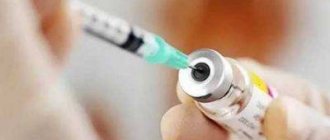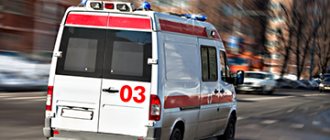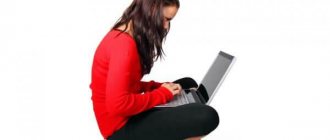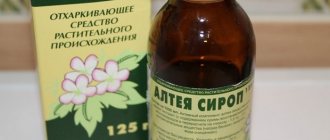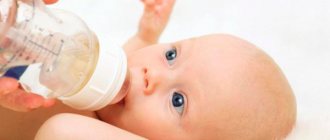Most often, a child’s temperature rises due to infectious diseases. The baby becomes lethargic and complains that something hurts. This is how the immune system fights pathogenic microbes that have entered the body. Biochemical reactions accelerate, antibodies are formed that destroy viruses and bacteria. Interferons protect cells from the penetration of harmful microorganisms and signal macrophages about danger.
If a child’s temperature fluctuates between 37 – 38°, then you should not use antipyretics. But if it rises to 38° and above, then measures need to be taken.
Efferalgan is a drug with an analgesic and antipyretic effect, which is taken to eliminate fever and persistent pain. There are different pharmaceutical forms of the drug, but not all of them are suitable for children.
Efferalgan: composition and properties
The main component of Efferalgan is paracetamol, the dosage forms of the drug differ only in additional components:
Baby syrup:
- polyethylene glycol 6000;
- a mixture of sucrose and water;
- food additive E954;
- potassium salt of sorbic acid;
- food additive E330;
- aromatic additives “Caramel” and “Vanilla”;
- distilled water.
Candles:
- solid fats.
Pills:
- food additive E330;
- soda ash;
- sodium bicarbonate;
- sorbitol;
- a mixture of saccharin and water;
- docusate sodium;
- low molecular weight polyvinylpyrrolidone;
- sodium salt of benzoic acid.
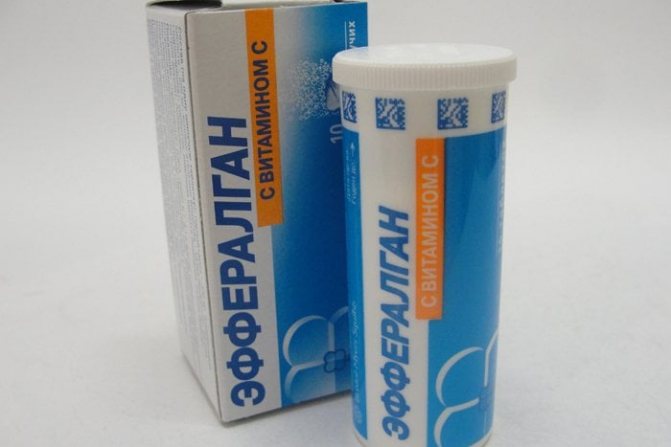
The medication is in the form of white tablets that provoke an effervescent reaction when dissolved; 1 piece contains 50 mg of the active substance (paracetamol). The syrup is a thick amber-colored liquid with the smell of vanilla and caramel. Contained in a dark bottle with a measuring cup. Suppositories are white in color, packaged in blisters. The concentration of the active substance in the suppositories is different: 80 mg and 150 mg.
Efferalgan is a medicine that reduces fever, eliminates pain, and has a mild anti-inflammatory effect. The active component penetrates the blood and blocks the production of prostaglandins. Paracetamol affects the centers of pain and thermoregulation.
Cell peroxidases neutralize the effect of the main substance on cyclooxygenases in the area of inflammation. As a result, the anti-inflammatory effect is rather weak. The drug does not disrupt water-salt metabolism and does not damage the mucous membrane of the stomach and intestines.
The active ingredient is quickly absorbed into the walls of the small intestine. Its maximum amount in the blood appears after half an hour or an hour. The medication is quickly distributed throughout the tissues and excreted in urine.
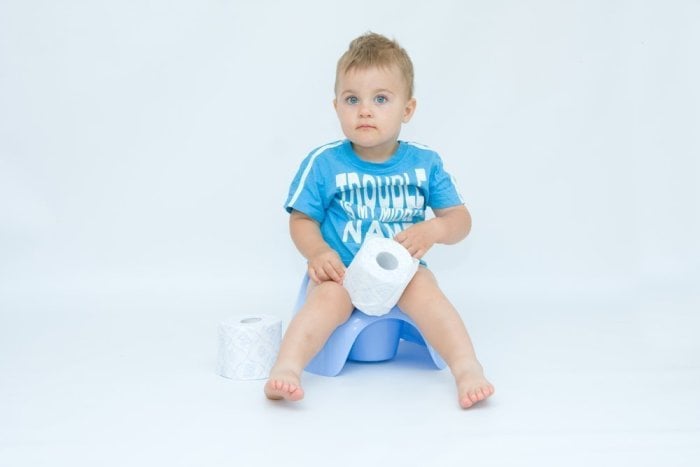
Purpose of the drug
According to the instructions for use, Efferalgan in tablet form is prescribed for moderate pain:
- Headache, toothache.
- Pain in the lumbar region.
- Myalgia.
- Burns and injuries.
- Painful menstruation.
- Fever with chills during colds and other infectious diseases.
Syrup for children is prescribed to patients from 1 month of age (weighing from 4 to 32 kg) in the following cases:
- Normalization of temperature during a cold, infectious disease or in the post-vaccination period.
- Pain of various origins.
Efferalgan suppositories for children are also used to relieve fever due to a cold or infection, as well as to relieve pain.
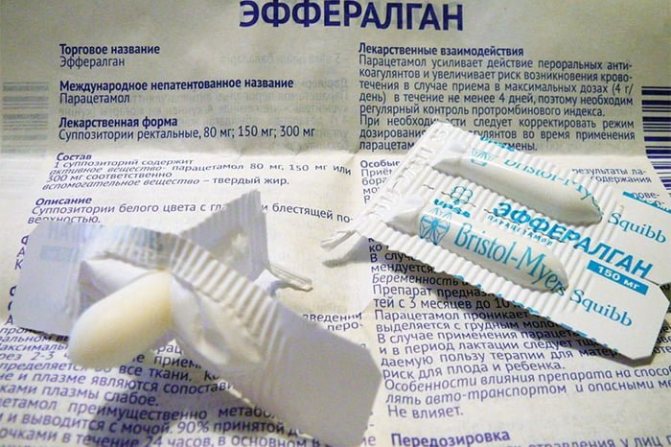
How to reduce the temperature of a month-old baby? – Mother and child
Medicinal antipyretics are not recommended for use in newborns from the first days of life until one month.
There are no pharmaceutical drugs whose annotations would indicate the possibility of using them in children under one month of age.
For older children, there are a number of safe medications that can successfully reduce high fever. They can be given to a child only after consultation and prescription by a doctor.
How to reduce the temperature of a newborn baby 1-6 months old at home
Newborn babies are a source of not only boundless joy, but also anxiety. They do not yet know how to speak, so young parents are afraid to misrecognize the reasons for crying or not notice serious health problems. The child’s body temperature is often a cause of concern – the mother always thinks that it is higher than it should be normally.
https://www.youtube.com/watch?v=TpuHdz2e3ZM
Baby and thermometer
Normal body temperature of a baby
Infants, due to the peculiarities of metabolic processes, have a body temperature slightly higher than the average for a healthy adult of 36.6˚C. Different ages have their own upper limits of normal:
- newborn – 36.8˚C;
- from 1 to 5 months – 37.5˚C;
- 6-9 months – 37.7˚C;
- 9-12 months – 37.5˚C.
Attention! The data presented reflect the indicators obtained by measuring body temperature in the armpit.
Measuring a baby's temperature using a conventional mercury thermometer is not an easy task.
The baby refuses to lie still with his hand pressed to his body, a cold object causes him discomfort, and children 11-12 months old are frightened by its springlike appearance because it resembles a syringe.
Therefore, to preserve children's peace of mind and facilitate mother's work, electronic and infrared thermometers were invented, allowing one to find out the baby's body temperature, bypassing the difficult task of holding the device in the armpit.
An electronic thermometer in the form of a pacifier is a real salvation; the baby sucks on a pacifier, the screen of which displays information. Indicators obtained from the oral cavity are 0.6˚C higher than those that could be obtained in the same period of time from the armpit. Therefore, a pacifier thermometer may show 37.2˚C in a newborn, this will be the norm.
Infrared thermometers are considered the most accurate, and they are also the most convenient, because they give results in 2 seconds. As a rule, the device has two attachments: for measuring in the ear canal and on the temporal artery.
Just press the measurement button and hold it for 2 seconds, after which the result will appear on the screen.
However, it is not suitable for measuring temperature in children under 3 months, since the indicators will be unreliable due to the characteristics of metabolism.
Infrared thermometer
Additional Information. Measurements obtained from the ear cavity will differ by 1˚C more from the temperature that a mercury or electronic thermometer would show at a given moment in time if it were in the armpit. Therefore, for a six-month-old baby, 38˚C in the ear cavity can be the absolute norm.
Application and dosage
The medicine in tablets is taken orally, but must first be dissolved in a glass of water. The standard daily dosage of the medication is 1 or 2 pieces twice or three times a day. The interval between doses is 4 hours.
In case of disorders of kidney or liver functionality, the daily dose is reduced and the interval is increased to 8 hours. The therapeutic course is 5 days (to relieve pain) or 3 days (to reduce high fever).
Before you start treating your child with syrup, you need to carefully study the instructions. A single dose depends on the patient’s weight - 10 or 15 mg/kg, frequency of use - three times in 24 hours. The maximum daily dose of the drug is about 60 mg/kg.
The interval between medication doses is from 4 to 6 hours. A measuring spoon, which is sold complete with syrup, will help you accurately measure the appropriate dose. In case of kidney dysfunction, the interval between doses is 8 hours.
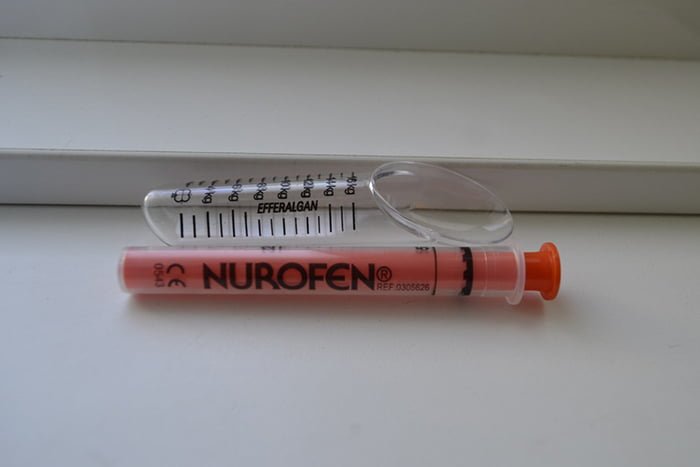
If the child refuses to take the syrup, then the liquid is diluted with milk or water. Although most often children like the taste of the medicine and take it with pleasure.
To eliminate fever with chills, Efferalgan is used for 3 days, and for pain relief - 5 days. The decision to extend the therapeutic course is made by the doctor.
Suppositories are inserted into the anus; suppositories with a concentration of the active substance of 150 and 80 mg are used for treatment.
The daily dosage for patients weighing 60 kg or more is 500 mg four times. Suppositories are used systematically for 5 or 7 days. It is prohibited to use more than 4 g of the drug in 24 hours.
Daily dose of medication for children of different ages:
- from 1 to 3 months – 10 mg/kg;
- from 4 to 12 months – from 60 to 120 mg/kg;
- 12 months – 5 years – from 120 to 250 mg/kg;
- 5 – 12 years – from 250 to 500 mg/kg.
It is allowed to administer suppositories no more than 4 times per day; the course of treatment lasts 3 days.
The final dosage and duration of the course are determined by the pediatrician individually for each patient.
What temperature should be lowered in a baby?
Many parents, who do not know the peculiarities of the functioning of the child’s body, begin to worry about every symptom that arises in their newborn. Spots on the body, elevated temperature, too frequent and long sleep - all this causes anxiety in them.
What temperature should be brought down in a baby is not an easy question. The answer to it depends on the age of the baby, his general condition, as well as the reasons that provoked it. So, in children under 6 months of age, a temperature within 37-37.5 degrees is considered normal.
Small distortions up and down indicate only the underdevelopment of the thermoregulation center. If it has risen to 38 degrees, then in the absence of other pathological symptoms there is no need to bring it down with medications.
In such a situation, the newborn should be undressed so that his body can breathe. Most likely, it just overheated.
Why does the temperature rise
In an infant, it can indicate both an infectious disease and causes that have nothing to do with it. In any case, if the baby behaves normally no matter what its readings are (unless, of course, it is higher than 39 degrees), then there is no need to knock it down.
So, what reasons can cause an increase in temperature:
- ARVI;
- angina;
- overheat;
- reaction to stress;
- teething;
- bathing in hot water;
- allergic reaction;
- dehydration of the body;
- vaccination;
- influence of ultraviolet rays;
- colic;
- binge eating;
- prolonged crying.
As can be seen from the above, for the most part the reasons for the rise in temperature are harmless, so there is no need to panic when only this symptom appears. Antipyretic medications are considered necessary only when, against the background of fever, the baby experiences convulsions, pale skin and vomiting.
Attention! Under no circumstances should children under one year of age be rubbed with alcohol. Ethanol will penetrate the baby's body through the skin and then harm its health.
If a child develops any pathological symptoms in addition to fever, you should definitely call a doctor.
Baby's temperature
36-38 degrees are physiologically normal for babies. However, if a baby at a temperature of 37.5 and above constantly cries, eats poorly, has diarrhea or vomiting, then this means that in this case it is pathological in nature.
According to WHO, there is no need to lower the temperature in the absence of other signs of illness, even when the mark on the thermometer has reached 38.5 degrees. However, if the child is not yet 2 months old, has chronic diseases, or has experienced convulsions in previous times when it increased, then it should be brought down at a value of 38 degrees.
What does a temperature of 37 degrees mean?
in newborns, it only indicates that their thermoregulation has not yet been fully formed. You shouldn’t wrap your child in a lot of clothes just because of his small age. most often this is the cause of a slight increase in temperature. As a rule, newborns tolerate such thermometer readings normally.
Is a temperature of 38 degrees a reason to be nervous?
if the baby’s behavior has not changed (he eats well, smiles, chatters), then you don’t have to knock her down. In this way, the baby’s body fights the infection that has entered it. To maintain the normal condition of the baby, you should often give him water, compote, and if he is breastfed, then the nursing mother should often put him to the breast.
temperature 39 and above – it’s time to turn to medication
It is necessary to call an ambulance if his legs and arms become cold, he refuses to breastfeed, his heartbeat quickens, his eyes become blurred, and his breathing becomes difficult. these symptoms indicate the development of white fever in the infant. The baby should be given antipyretics, take off his clothes and give him some water to drink.
how to measure a baby's temperature
Its measurement should take place a quarter of an hour after bathing, feeding, massage or gymnastics.
We recommend reading: Normal temperature in a baby
If it is measured immediately after these procedures, it will be increased.
You can check it in the following ways:
- in the inguinal fold or armpit;
- orally using nipple thermometers;
- rectally;
- in the ear, on the forehead using special infrared thermometers;
- without touching your forehead using a non-contact thermometer.
When measuring the temperature in the rectum, you should know that it differs from normal values by 1 degree. With the oral method - by 0.5 degrees.
What is allowed to bring down the temperature in a newborn?
If the baby has become lethargic, stopped eating, and his hands and knives have become cold, then it is urgent to bring down the temperature by any means. Children under one year of age can use the following medications:
- "Ibuprofen."
- "Nurofen".
- Syrup "Paracetamol for children".
- Candles "Viferon".
If the temperature rises after vaccination, you can use Viburkol suppositories.
How to use
When choosing the dosage of the drug, you should pay attention not to the age, but to the weight of the baby. When using syrup, you must first warm it to body temperature. To do this, you just need to support it a little in the palm of your hand.
It can be given no more often than stated in the instructions for it. For example, ibuprofen is allowed to be given to the baby again only after 4 hours, and paracetamol - 6. If it still does not go astray, then you need to call an ambulance.
Attention! Giving analgin to a newborn is strictly prohibited.
So, they usually lower a baby’s temperature if it is above 38 degrees (if he is not yet 2 months old), and also if he has symptoms such as convulsions and vomiting.
Source: https://floragaz.ru/zdorovye/kakuyu-temperaturu-nuzhno-sbivat-grudnichka
An increase in temperature in an infant is always a symptom of some disease. This symptom is positive, it means that the body is adequately responding to the onset of the disease.
It is known that at body temperatures above 38 ⁰C, viruses and bacteria stop multiplying and begin to die. Fever is also a prerequisite for the production of interferon. Despite this, fever always causes panic in the family and is accompanied by a search for an answer to the question, how to reduce the temperature of a baby?
Causes
1. Viral, bacterial and fungal infections come first. In order for all parts of the immune system to work harmoniously, special conditions are needed - increased body temperature.
2. Babies often overheat in a stuffy environment when they are wearing many layers of clothing. Therefore, before wondering how to lower a baby’s temperature, try to cool him down a little, remove excess diapers, and give him a drink of water or milk.
3. Infants often react with fever to stress, fear, or an uncomfortable situation. The reason is the functional immaturity of the thermoregulation center.
4. Autoimmune processes.
5. Oncological pathology.
What temperature can you lower?
There are several rules that health workers adhere to when they are asked how to bring down a baby’s temperature?
1. Fever above 38.5 ⁰C is subject to drug correction for children of all ages.
2. Babies who are not yet 3 months old are given an antipyretic at the border of 38 ⁰C due to immaturity of the brain.
3. Children who have congenital and acquired diseases of the lungs, heart, kidneys, and central nervous system need to bring down the temperature.
4. Fever is brought down for all children without exception who have had a history of seizures due to fever (febrile seizures).
5. There are children who do not tolerate the disease well: they are lethargic, not interested in toys, refuse mother’s milk and cry. An antipyretic is also indicated for children.
How to reduce a baby's temperature?
So, we have decided who needs to bring down the fever. What to do next?
1. Undress the baby. Make sure that the skin breathes and heat exchange occurs.
2. Offer the baby fluids often enough. Breastfed babies may refuse to breastfeed during illness. Fever is an indication for supplementing with water.
3. Rub the baby with warm water and leave it to evaporate. You can leave a cool (20 ⁰C) compress on the forehead and liver area (on the right side) - they are intensively supplied with blood, and the blood will cool faster.
4. If physical methods do not help, then take out an antipyretic from the first aid kit. You may ask why we didn't do this right away?
Firstly, the cause of the fever could be a banal overheating of the baby, which we could deal with using the methods described above.
Secondly, it is unknown how the body will behave during the disease. It is possible that the temperature will rise frequently, so the less medicine we use to reduce it, the better. Many babies respond well to physical methods to reduce fever.
So, among the antipyretics in your medicine cabinet there should be only Paracetamol and Ibuprofen in suppositories or syrup. If the baby has not yet been introduced to complementary foods, and he instinctively pushes out the spoon, then use rectal suppositories or pour the medicine into the mouth with a syringe.
Despite the fact that the antipyretic effect of both drugs is the same, pediatricians primarily choose Paracetamol. It is allowed from 3 months, and by doctor’s prescription from 1 month of life.
Ibuprofen is given to children from 6 months, but in practice it is also possible to use it at an earlier age. It is not recommended for use in chickenpox, as complications such as bacterial fasciitis are possible.
What you should never do
Now you know how to bring down a baby’s temperature. But there are things that cannot be done:
1. Follow popular advice and wipe the crumbs with diluted vodka or vinegar. The World Health Organization notes that they are absorbed through the baby's skin, which can easily cause poisoning.
2. Give the following drugs:
Analgin (Metamizole). It is excluded from children's medications due to the risk of causing anaphylactic shock, prolonged hypothermia, fainting, and a sharp decrease in granulocyte cells responsible for cellular immunity.
Aspirin. Prohibited in children under 15 years of age due to the risk of causing Reye's syndrome and liver failure.
Nimesulide. Dangerous due to liver damage and toxic jaundice. Allowed in the CIS after 12 years. Despite this, all licenses for this drug were revoked in the USA and Europe.
When should you call an ambulance?
- If after taking an antipyretic the temperature not only did not decrease, but also increased.
- If there is no response to medication, and the child’s hands and feet are cold, the so-called white fever has appeared.
- If there are convulsions, fainting.
- If the baby has difficulty breathing, he turns blue.
- If the fever appears against the background of an existing severe pathology, then it is better for such a child to call an ambulance and be treated in a hospital.
Source: https://nasha-mamochka.ru/o-detyah/do-goda/kak-sbit-temperaturu-u-grudnichka/757
Precautionary measures
The use of the drug in tablets is prohibited if there are the following contraindications:
- Alcoholism in chronic form.
- Glucose-6-phosphate dehydrogenase deficiency.
- Before the 13th week of pregnancy and after the 27th week.
- Lactation period.
- Children under 15 years of age (if the child weighs less than 50 kg).
- Hypersensitivity to the components of the drug.
In case of dysfunction of the liver or kidneys, increased concentration of bilirubin in the blood serum or hepatitis of viral origin, Efferalgan is taken under the supervision of a physician. This limitation applies to elderly patients.
Medication in the form of a suppository and syrup is also sometimes prohibited from taking:
- Newborn up to 1 month.
- Hypersensitivity to components.
- Functional disorders of the liver or kidneys.
- Blood diseases.
The syrup is taken by diabetic children under the supervision of a doctor. Suppositories are not used for diarrhea.
In case of contraindications, negative phenomena occur:
- nausea, vomiting;
- allergies in the form of skin rash, itching, urticaria, angioedema;
- irritation of the inner lining of the rectum;
- anemia, decreased levels of platelets, leukocytes, increased levels of methemoglobin.
When consuming the syrup, diarrhea, abdominal pain, anaphylaxis occur, blood pressure decreases, etc.
An overdose of syrup or suppositories is manifested by nausea, vomiting, painful sensations, increased sweating, and pale skin. These symptoms appear within 24 hours after consumption. After taking too high doses of medication, the child experiences hepatonecrosis, functional liver failure, encephalopathy, etc. There is a risk of coma and death.
If such symptoms occur, do not give the child the medicine and hospitalize him immediately. The doctor will rinse the stomach (if the medicine is taken orally) and administer an antidote.
Similar medicines
If there are contraindications to taking Efferalgan, it is recommended to select safer medications. Analogs of drugs with a similar effect based on paracetamol:
- Sanidol;
- Panadol;
- Strimol;
- Paracetamol;
- Tylenol, etc.
Thus, Efferalgan for children is an effective drug that eliminates fever with chills and relieves moderate pain.
The medication is used to treat a child only for medical reasons. After use, monitor the baby's condition. If a negative reaction occurs, stop taking the medication and contact your pediatrician. Subscribe to our VKontakte group
Which antipyretic is suitable for newborns?
An antipyretic for newborns is a must-have in the home medicine cabinet. When collecting a dowry for a newborn, you need to put together a first aid kit for children in advance. This is necessary to ensure that all the necessary medications are at home and can be used if necessary.
When a baby, especially if he is the first-born, has a rise in body temperature, even slightly above normal, parents panic. But in any case, antipyretics for newborns should be safe. The normal temperature for infants is from 36.6 to 37º.
An increase in temperature may signal that there is an infection in the child’s body and the immune system is actively fighting it. It is very important that a child at the age of 1 month should be examined by a pediatrician, only after which a specialist can prescribe any safe drug.
It is not allowed to give any medications to a child under 2 months of age.
The benefits and dangers of increasing body temperature
When the baby's body is attacked by pathogenic viruses and bacteria, it increases body temperature. This measure is necessary in order for natural interferon to be produced.
Another advantage of temperature is that at high temperatures the virus is not able to reproduce, as a result of which its cells die.
Thus, a fever in a child helps to heal and build natural immunity.
If the temperature varies up to 38º, doctors recommend not giving the child antipyretics. But after the temperature overcomes the barrier of 39º, this is already dangerous, as the child may have an attack of convulsions.
Therefore, according to the recommendations of most doctors, the average temperature at which a child needs to be given antipyretics is considered to be a temperature of 38.5º. But at the same time, one should take into account the general condition of the child, the presence of any congenital pathologies.
Because such babies are at risk, a high temperature can become dangerous for them. Although the child is given an antipyretic, he should still be fed, that is, given as much warm fluid as possible.
What medications are used for newborns?
The best option for infants is to avoid any medications, but if an emergency arises, it is recommended to invite a doctor who, after an examination, will select the least dangerous drug for the child.
The most common drugs used to treat infants are paracetamol and ibuprofen. For newborn babies, these drugs are used in 2 forms:
- Syrup or suspension for newborns.
This form is convenient because the medicine is quickly absorbed and begins to act, it is easy to dose, and it tastes good. But the disadvantage of such drugs is that they often contain dyes and flavorings, to which a child may have an allergic reaction. - Suppositories for newborns are a more acceptable form; they do not contain additives, and their effect is longer - up to 6 hours.
The disadvantage of such drugs is that they take longer to act than syrup. Antipyretic suppositories do not negatively affect the body. Up to 3 months, it is better for a child to use candles.
The speed of action of the drug can tell a lot about what disease the baby has. If the suppositories work and the temperature drops, we can say that the baby has an acute respiratory viral infection.
If the drugs do not help bring down the temperature, a more serious disorder in the child’s body can be judged.
Temperature after vaccination
Immediately after the baby is born, it is protected for some time by the natural immunity received from the mother. But upon reaching a certain age, the baby needs to be vaccinated. Today, many parents refuse this procedure. Opinions are divided here, but doctors still advise getting vaccinated.
After vaccination, the temperature may rise. If it does not exceed 38º, an antipyretic should not be used. The safest drug for young children is Paracetamol. The most convenient form for use in children of this age is considered to be candles. Up to 3 months, it is better to use this particular form of medication.
You can try to lower your temperature without using medication. To do this, you should give the baby plenty of fluids and put him to the breast often. Next, the child should be undressed (no need to wrap him up, it’s better to let him be naked), just cover him with a diaper. You can try wet wiping, but under no circumstances use compresses with vodka or vinegar - this can cause intoxication in the baby.
Rules for taking antipyretics
For newborn babies, medications are usually prescribed in the form of syrup, suspension or suppositories. Candles are considered the most effective. You should adhere to the rules for taking medications, do not give antipyretics if the temperature does not rise to 38º. It is necessary to comply with the dosage of medications. Doctors do not advise giving a child antipyretics in combination with antibiotics.
There are also prohibited drugs that should not be given to children. Among them are Analgin, Nimesulide, Acetylsalicylic acid, Antipyrine. Such drugs can cause serious pathologies of the liver and circulatory system in infants. It is necessary to feed the baby breast milk more often, cover him with a diaper, and ventilate the room.
You definitely need to wait for the pediatrician, only he can choose the safest remedy.
Don't panic: the mother's condition is passed on to the child. He may be capricious and cry. It is necessary to remain calm and strictly follow the doctor's instructions.
Source: https://RebenokZabolel.ru/lekarstva/zharoponizhayushhee-dlya-novorozhdennyx.html
